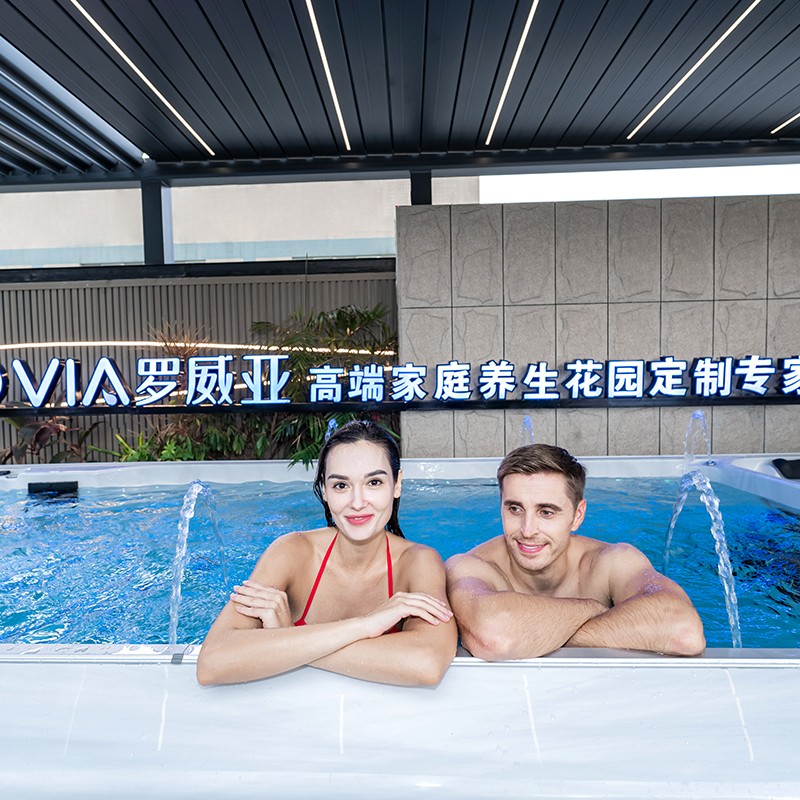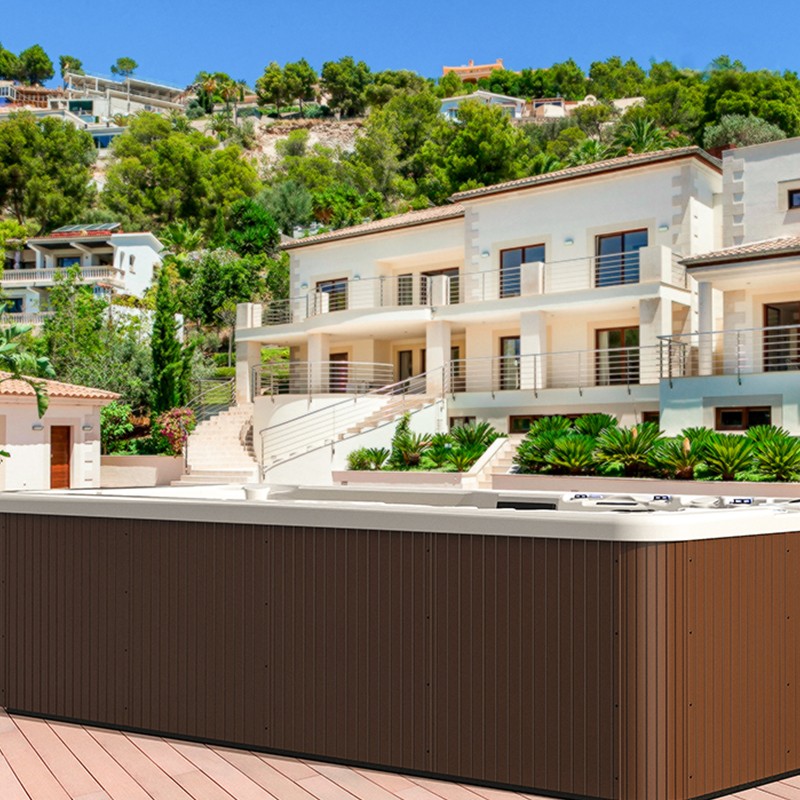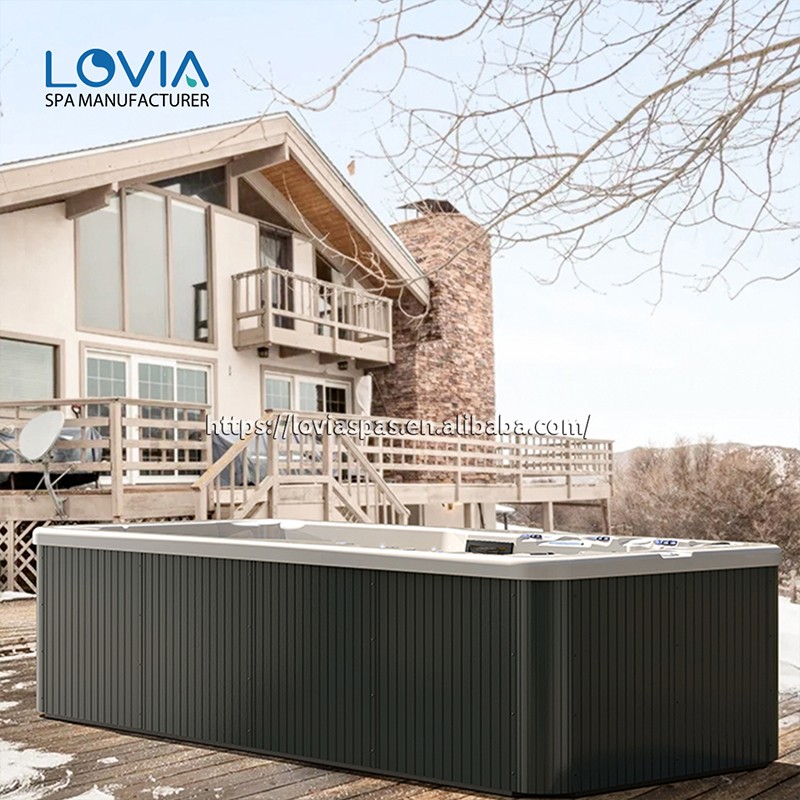
Why Shouldn't Swim Spa Hot Tubs Be Filled Too Full?
2025-11-13 15:35In modern family health lifestyles, swim spa hot tubs have become essential equipment for relaxation, exercise, and therapy. They combine the dual functions of heated swimming and massage therapy, providing users with a comfortable and efficient aquatic experience.
However, many users have questions when using a swim spa hot tub for the first time:
"Why can't I fill it as full as possible? Wouldn't more water make it more comfortable and closer to the feeling of a swimming pool?"
In fact, swim spa hot tubs have strict requirements for water level. Excessive water level not only doesn't improve the experience but can also cause decreased equipment performance, system malfunctions, and even safety hazards.
This article will comprehensively explain why swim spa hot tubs shouldn't be filled too full from the perspectives of physical structure, water pressure principles, system operation, safety, and maintenance.

Ideal Water Level Height for Swim Spa Hot Tubs
While a swim spa hot tub may look like a small swimming pool, it is essentially a highly integrated hydraulic system, including a circulation pump, filtration system, jets, overflow device, control panel, and heating system.
Each component requires a specific water level to function stably. Manufacturers typically include one or more graduated lines on the inner wall of the bathtub to indicate the ideal water level. This line is usually located about 5–10 cm below the nozzle.
Excessive water level can disrupt the system's pressure balance and circulation efficiency. The main reasons are as follows:
1. Water Pressure Load Variation
When the water volume exceeds the design limit, the overall static water pressure rises significantly, leading to increased pump resistance.
The pump, motor, and piping will therefore experience additional pressure, increasing equipment wear.
2. Limited Air Circulation
The jet system requires sufficient air intake space to mix with the water flow and create a massaging effect.
If the water level is too high, the air vents are submerged, preventing the system from drawing in enough air, resulting in weakened water flow and uneven jets.
3. Overflow and Safety System Failure
Most swim spa hot tubs are equipped with an overflow prevention design, but this only works if the water level is within a safe range.
When overfilled, water can easily overflow during use, causing moisture damage to the electrical control system or the surrounding floor.
Therefore, from a structural design perspective, the water level in a swim spa hot tub must adhere to the manufacturer's specifications and must never exceed the maximum safe water level.

Overfilling the tub will cause an imbalance in the circulation system
1. Excessive Pump Load and Reduced Efficiency
The circulation pump in a swim spa hot tub is responsible for continuously propelling the water flow, creating a strong jet through the nozzles to achieve therapeutic or swimming functions.
If the tub is overfilled, the water pressure increases, and the resistance during pump startup also increases, leading to the following problems:
• Increased motor current, resulting in increased energy consumption;
• Increased pump body temperature, easily triggering the thermal protection device;
• Long-term high-load operation will shorten the equipment's lifespan.
In short, too much water will cause the pump to "suffocate," significantly reducing its operating efficiency.
2. Turbulent Water Flow in the Jet System
The nozzle's outlet pressure is closely related to the water level. Under normal circumstances, an air layer remains above the jet nozzle to maintain air-water mixing.
However, when the water level is too high, the air is completely covered, causing the water flow to become:
• Slow and weak;
• Fewer bubbles;
• Reduced massage and impact effects.
This directly affects the main functional experience of the swim spa hot tub.
3. Insufficient Water Circulation
Excessively high water levels may submerge the filter inlet to an unreasonable depth, affecting the filter's water absorption capacity.
Poor water circulation makes it difficult to remove impurities, leading to:
• Turbid water;
• Impurity accumulation;
• Reduced disinfection effect.
Therefore, an appropriate water level not only affects equipment performance but also directly impacts water quality.

Excessively high water levels pose risks to the electrical control and safety systems
The swim spa hot tub is a complex device that combines water and electricity; the electrical control system needs to operate in a safe, waterproof environment.
Excessive water level may cause the following safety hazards:
1. Water ingress risk to the control panel
If the water level is close to the control area or the user operates the panel at a high water level, water vapor or droplets may seep into the control system, causing short circuits or button malfunctions.
2. Sensor misjudgment and alarms
Water level sensors are usually installed at a fixed height to detect whether the water volume is normal.
Overfilling the tub can cause the sensor to malfunction, resulting in false alarms or shutdown.
3. Risk of water accumulation and electric leakage
Overflowing water may flow into the power interface, heating unit, or external cable tray, posing a risk of electric leakage.
Therefore, from a safety perspective, controlling the water level is essential for ensuring the safe operation of the swim spa hot tub.
Overfilling the tub can affect the user experience and comfort
Many people mistakenly believe that "more water is more comfortable," but for the swim spa hot tub, the opposite is true.
1. Excessive water movement
When a user enters the spa tub, their body volume creates a drainage effect.
If the water level is too high, even slight movement will cause water to overflow, wasting water and making the floor slippery, increasing the risk of falls.
2. Unnatural bathing posture
When the water is too deep, users in sitting or lying positions may experience excessive buoyancy, making it difficult to stabilize their bodies and reducing the accuracy of the massage.
3. Obstructed air circulation, reduced comfort
The bubble system of the swim spa hot tub relies on air mixing. Excessive water level makes it difficult for bubbles to be released, significantly weakening the airflow during the massage and reducing comfort.
Therefore, controlling the water level appropriately not only helps balance the system but also allows the body to receive more natural support and a better massage effect.
Excessive water level increases maintenance and cleaning difficulty
1. Increased load on the filtration system
More water means longer filtration time and a correspondingly longer cleaning cycle.
At the same time, excessive water pressure will put more pressure on the filter element, shortening its lifespan.
2. Overflow causing external pollution
Overflowing water can easily flow into floor crevices, breeding mold or bacteria and compromising environmental hygiene.
3. Chemical Concentration Imbalance
Excess water dilutes disinfectants and pH adjusters, making water quality management difficult.
To maintain effectiveness, users must increase the dosage, resulting in waste and increased maintenance costs.

Why can't the water filling standard for a swim spa hot tub be adjusted arbitrarily?
Each swim spa hot tub system is precisely designed and tested.
Manufacturers typically provide clear filling guidelines, including:
• Recommended water level lines;
• Minimum and maximum operating water levels;
• Commissioning and drainage methods.
These standards are determined based on a combination of factors:
• System hydrodynamic balance;
• Nozzle efficiency;
• Safe distances for electrical components;
• Drainage and overflow prevention performance.
Arbitrarily changing the water filling volume disrupts the design balance.
Even adding just 5 cm of water can alter the pump pressure profile, causing performance fluctuations.
Therefore, whether for initial use or after a water change, strictly follow the instructions for filling; never add water based on intuition.
How to determine if the water level in a swim spa hot tub is appropriate?
You can quickly verify the water level using the following methods:
1. Observe the nozzle status
After the jet system is activated, if the water flow is even, there are sufficient bubbles, and there is no obvious splashing, the water level is appropriate.
If the nozzle's water flow is weak or the splashing is too large, the water level may be incorrect.
2. Check the overflow or inlet
The water level should be slightly lower than the overflow outlet by 2-5 cm. This prevents overflow and ensures smooth circulation.
3. Comfort test
When a person enters the bathtub, the water level should just cover the area around the shoulders. If a large amount of water overflows, it indicates that too much water has been added.
Maintaining a proper water level not only ensures stable system operation but also improves overall comfort and energy efficiency.
The Chain Reaction of Overfilling a Swim Spa Hot Tub
Overfilling is not just a simple matter of water overflowing; it can cause a series of problems:
• Increased water pressure → Pump overload → Motor overheating → Automatic shutdown;
• Unstable water flow → Abnormal air mixing in the nozzles → Reduced massage effect;
• Increased filter load → Increased cleaning frequency → Increased maintenance costs;
• Water overflow → Electrical wiring becoming damp → Increased safety risks.
This illustrates that a seemingly small operational error can lead to a chain reaction throughout the system.
Therefore, controlling the water level is not only necessary for maintaining performance but also fundamental to ensuring safety and stability.
How to maintain the appropriate water level in different usage scenarios?
The optimal water level for a swim spa hot tub varies slightly depending on the intended use:
Usage Types | Recommended water levels | Features |
| Therapeutic Relaxation | Approximately 5 cm below the nozzle | Maintains ample massage airflow |
| Swimming Impact | 3–5 cm below the nozzle | Maintains balanced water flow resistance |
| Multi-person Use | 10 cm below the overflow outlet | Allows drainage space to prevent overflow |
| Single Bath | 8 cm below the overflow outlet | Comfortable and energy-efficient |
Regardless of the purpose, at least 5 cm of safety margin should be reserved to prevent water overflow when the body enters.
What Makes LOVIA SPA One of China’s Top 5 Spa Brands?
LOVIA SPA was proudly recognized as one of China’s top 5 spa brands in 2019 — a result of decades of consistent quality and innovation. Since 1989, we’ve built a reputation as a reliable manufacturer combining advanced technology with affordable pricing. Buyers appreciate our long warranties, certified materials, and quick delivery.
Our products are exported worldwide under the LOVIA SPA brand, representing luxury, comfort, and value.
